
Discover how TTS in Business Communication Systems transforms customer service, training, and daily operations. Your complete guide to modern speech technology solutions
Text-to-speech, or TTS in Business Communication Systems, is transforming the way companies connect with their audience. What started as basic robotic voices has evolved into amazingly human-like speech technology. Thanks to advanced AI, these modern TTS in Business Communication Systems can turn written words into natural-sounding conversations.
When a business uses TTS, the software breaks down the text, figures out how it should sound, and speaks it in a way that feels natural and engaging. This makes information easier to access for everyone and helps companies work smarter. Plus, it gives customers a better experience when they’re interacting with businesses.
Think of TTS as your company’s digital voice – it’s everywhere from helpful virtual assistants to customer service hotlines and employee training programs. It’s completely changing the game in how we share and receive information across different industries.
Key Takeaways
- Text-to-Speech (TTS) technology has evolved a lot, thanks to new voice generation methods and deep neural networks.
- TTS makes communication better by making it more accessible, efficient, and personal. It helps businesses talk to customers in a more engaging way.
- TTS is now a big part of business communication systems. It’s used in automated customer service, interactive voice response, and more.
- Using TTS can make businesses run better, save money, and give customers a more personal experience.
- The future of TTS looks bright. It will get even smarter, making voice-controlled interactions and device management seamless.
Understanding the Evolution of Text to Speech Technology
The history of text to speech (TTS) goes back to the 1960s. Pioneers like Noriko Umeda and John Larry Kelly Jr. started it. They used early methods like Concatenative TTS and Parametric TTS.
Over time, many important steps have been taken. These steps have made TTS technology better.
From Early Innovations to Modern Solutions
In the early 20th century, the first electronic speech systems were made. DECtalk, from Digital Equipment Corporation in 1984, was a big step. It sounded quite natural.
The 2000s brought a big change with neural networks and deep learning. Google DeepMind’s WaveNet in 2016 set a new high for TTS quality.
Key Milestones in TTS Development
- End-to-end TTS models like Tacotron and Deep Voice were introduced. They could make speech from text directly.
- Big datasets of human speech helped train TTS models. This made them mimic natural speech better.
- Neural coding like WaveRNN and WaveGlow improved synthetic speech quality. They made audio sound more real-time.
The Rise of Neural Network Approaches
Today, TTS uses Deep Neural Networks (DNNs). These use artificial intelligence and machine learning. This makes voice generation easier and more accurate.
This has led to many uses in text to speech synthesis, voice interfaces, and AI text to speech in business communication systems.
“The integration of TTS with natural language processing and sentiment analysis can lead to more empathetic voice interfaces.”
Now, researchers are working on making voices that sound like real people. They also need to think about ethics. Issues like voice cloning and deepfakes need rules for safe use.
TTS in Business Communication Systems: Core Components and Architecture
Speech-enabled apps and conversational AI are key in today’s business talk systems. At the center is text-to-speech (TTS) tech, turning written text into speech. The main parts of a TTS system are text analysis, language processing, and voice making.
The system’s design lets it work with current business systems. It uses APIs for voice calls and NLP for understanding voice. This setup helps businesses make unique voice experiences for talking with customers and team members. It also supports global audio chats, media streaming, and quick analysis.
TTS and AI together make talking systems that understand natural language. This tech mixes TTS, speech recognition, and NLP for a better user experience. It makes work more efficient and fun in many business areas.
“The integration of TTS with AI-powered business systems is transforming the way organizations communicate, both internally and with their customers.”
Using TTS and AI, businesses get many benefits. They improve customer service and make talking with the team easier. This mix of tech is changing how businesses talk to each other and their customers.
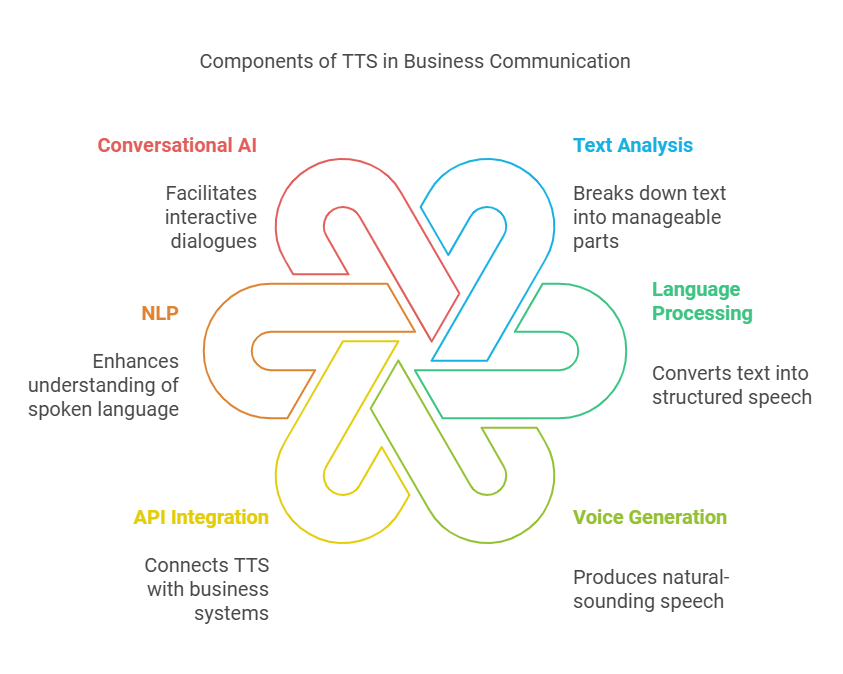
The Technical Foundation of Modern TTS Systems
The world of voice user interfaces and AI text-to-speech solutions has changed a lot. This change comes from better text analysis, voice synthesis, and working well with business systems. These new TTS systems help businesses use voice in their communication plans.
Text Analysis and Processing
At the heart of TTS systems is advanced text analysis and processing. This step breaks down sentences and words, understanding their meaning. It gets the content ready for speech that sounds natural.
Using NLP and machine learning, TTS systems handle language’s complexity. They make sure the voice matches the message well.
Voice Synthesis and Output Generation
The core of TTS systems is voice synthesis. AI algorithms like Tacotron and WaveNet create speech that sounds like a human. This technology lets businesses make voice experiences that are personal and engaging.
Integration with Business Systems
TTS’s real strength is how it works with business systems. It connects with CRM platforms, contact centers, and more. This connection makes businesses more efficient and responsive.
It lets businesses customize calls and use voice data in analytics. This improves customer interaction and business operations.
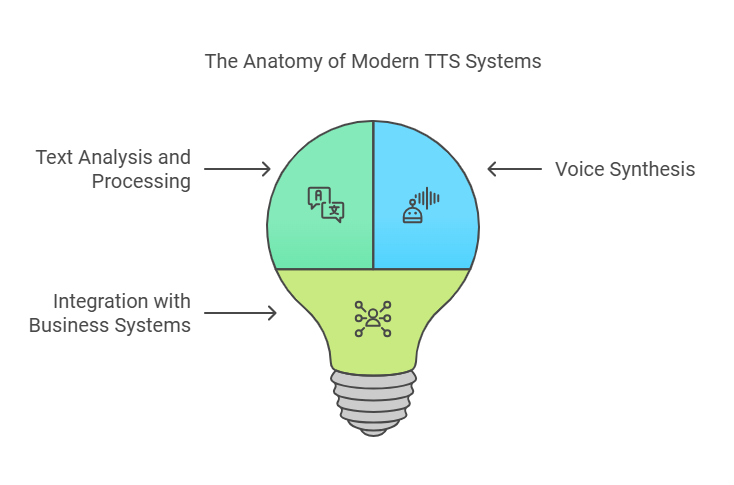
The technical base of modern TTS systems shows big progress in voice interfaces and AI. By using text analysis, voice synthesis, and integration, businesses can change how they communicate. They offer a more personal, efficient, and easy experience for everyone.
Benefits of Implementing TTS in Business Operations
Adding text-to-speech (TTS) tech to business systems brings many benefits. It makes things more accessible, efficient, and better for customers. TTS is changing how companies talk to their people.
TTS helps those with visual issues, dyslexia, or low reading skills. It turns written stuff into sound, making info available to more people. This makes businesses more inclusive and follows rules in many places.
TTS makes work better by letting people do more things at once. Workers can listen to updates or training while doing other tasks. This helps them manage their time better and work more efficiently.
Also, TTS makes customer service better. Automated voices and virtual helpers can speak in many ways. This makes customers happier and helps businesses save money and work better.
“TTS technology enables businesses to deliver information faster than traditional reading methods, making things more efficient for everyone.”
TTS does more than just these things. It makes businesses more open and user-friendly. It also makes work easier and cheaper. This tech is a big help for all kinds of companies.
Applications of TTS in Customer Service and Support
Text-to-speech (TTS) technology has changed how businesses talk to customers. It’s used in many ways, like in IVR systems and automated messages. This makes things more efficient and easier for customers.
Interactive Voice Response Systems
IVR systems with TTS can answer complex questions on their own. They sound natural and help customers find what they need. They also make it easier to give feedback after a call.
Automated Customer Communications
TTS helps send out routine messages like payment reminders and updates. These messages can be in different languages and on various platforms. It makes sure customers get a smooth experience.
Multi-channel Support Integration
TTS lets businesses talk to customers in many ways, like through chatbots and apps. This makes sure customers get a consistent experience, no matter how they contact you. It makes them happier and more loyal.
Using TTS can make customer service better and more enjoyable. By 2022, spending on customer experience tech will hit over $640 billion. Using TTS can really help businesses stand out.
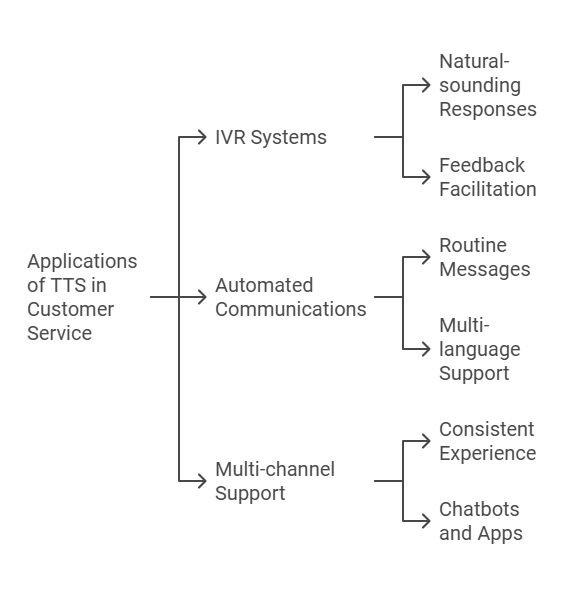
“Conversational AI voice assistants must have human-like TTS voices for effective deployment in various brand platforms.”
As more people use voice assistants, having good ai text to speech and text to speech synthesis is key. It helps businesses offer better and more engaging customer service.
Enhancing Accessibility and User Experience Through TTS
In today’s digital world, companies look for new ways to work better, save money, and make customers happy. Text-to-Speech (TTS) AI is a key tool in this search. It changes how businesses talk to and connect with people.
TTS AI lets companies handle more questions without needing more people. It works all day, every day, in many languages. This helps save money and time by making audio content for videos, podcasts, and more.
TTS AI has many uses in business. It helps with customer support, training, marketing, and learning. For example, CapCut, a popular video editor, has a Text-to-Speech tool. This makes making videos easy and fun for businesses.
The real strength of TTS is making things easier for everyone. About 1.3 billion people have vision problems. By 2050, one in six people will be over 65. TTS helps businesses talk to more people.
TTS also helps those with dyslexia, making reading and listening easier for them.
TTS makes people stay longer when listening to content. They can do other things like drive or work out. Studies show listening to audio helps people understand and remember better, even when they’re doing other things.
Companies using TTS get many benefits. They become more accessible, build their brand, engage more customers, and work better together. As the world changes, TTS and AI will be key in how businesses talk and connect with people.
“TTS technology can help break down language barriers, improving accessibility for non-native speakers and making content more engaging and understandable.”
TTS Solutions for Enterprise Communication
Businesses are looking to improve how they talk to each other. Text-to-speech (TTS) solutions are helping a lot. They turn written words into sounds that feel natural.
Internal Communications
TTS is key for talking to employees inside a company. It turns written messages into sounds. This way, everyone gets the news, no matter where they are or if they can’t read well.
This makes sure everyone knows what’s going on. It also helps people learn in their own way. This keeps everyone involved and informed.
Training and Development
TTS changes how we learn at work. It makes e-learning materials that everyone can use. This way, people can learn through listening and seeing.
This helps people remember what they learn. It also makes sure everyone can learn, no matter how they like to learn.
Corporate Announcements
TTS helps make sure everyone hears important news clearly. It turns written messages into sounds. This makes sure everyone gets the message the same way.
This makes communication better for everyone. It makes sure everyone hears important news clearly and in the same way.
As companies look to talk better and keep employees happy, text-to-speech solutions are a good choice. They use AI text to speech to make communication better. This makes work more efficient and fair for everyone.
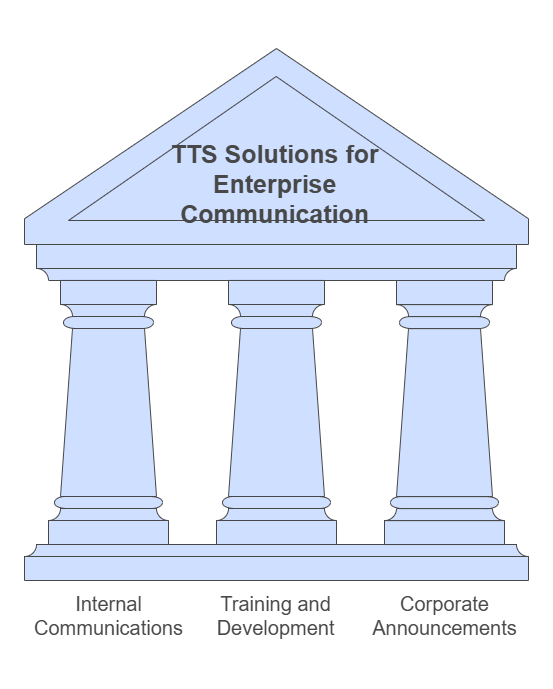
Voice AI and Conversational Interfaces in Business
Conversational AI and natural language processing are changing how we talk to machines. They make our interactions with technology feel more natural. Voice AI uses advanced tech to let us talk to machines easily, making customer service better and saving time.
Text-to-speech technology is making business apps smarter. It’s used in virtual assistants and smart IVR systems. These tools understand and answer our questions, making communication smoother and more efficient.
Using voice AI and conversational interfaces in business has many benefits. They make things more accessible, available 24/7, and personal. They also make businesses more efficient. As more businesses use these tools, they can serve their customers better and stay ahead of the competition.
“The rise of voice AI and conversational interfaces is revolutionizing business communication and streamlining processes across various industries.”
Virtual assistants like Siri and Alexa are just the start. Chatbots and in-car voice controls are also using conversational AI. These systems get better at understanding us as they learn from our interactions.
As conversational AI gets better, we’ll see it used more in business. It’s the start of a new era in communication. Businesses that use voice AI and conversational interfaces will innovate, improve customer service, and work more efficiently.

Implementation Strategies for TTS Integration
Adding text-to-speech (TTS) tech to business systems needs a smart plan. It’s important to think about planning, tech needs, and testing and use phases.
Planning and Assessment
First, figure out where TTS can help most. Look at how customers and staff talk, and what they need. This helps pick the right TTS for your business.
Technical Requirements
Choosing the right TTS provider is key. Check their voice quality, language support, and system fit. Also, make sure they handle data privacy well.
Testing and Deployment
Test the TTS system well before using it everywhere. Start with small tests to find and fix problems. This makes sure everything works smoothly.
With a good plan, businesses can add ai text to speech and text to speech synthesis. This makes customer service better, makes things more accessible, and boosts work efficiency.
“Implementing TTS in business systems requires careful planning, assessment of technical requirements, and thorough testing before deployment. A phased approach can help ensure a smooth transition and successful integration.”
Measuring ROI and Performance Metrics of TTS Systems
Text-to-speech (TTS) technology makes business communication better and happier customers. But, to see its real value, we must measure its return on investment (ROI) and track important metrics. This helps companies make smart choices and improve their TTS systems.
Customer satisfaction scores are key. By watching metrics like Net Promoter Score (NPS) and Customer Satisfaction Score (CSAT), we see how customers feel about TTS. Happy customers mean more loyalty, good word-of-mouth, and more money.
Reducing call handling times is also vital. TTS systems make customer talks faster, needing less human help and quicker answers. This makes work more efficient and lets more customers be helped with the same staff.
First-call resolution (FCR) rates are another important metric. A high FCR rate means TTS solves problems right away. This makes customers happier and calls shorter.
Being accessible to all is also key. TTS helps make sure everyone can use our communication, meeting rules and showing we care about everyone.
- Look at how much money is saved from needing fewer staff and less training.
- Watch how customers interact, like call numbers and how often they help themselves.
- See how TTS affects worker productivity and how well they do their jobs.
- Check how TTS makes work better and customers happier overall.
To really understand TTS systems’ worth, we need to look at both numbers and feelings. By using data, companies can make their ai tts business systems better. This leads to happier customers and more success with text to speech in business and automated voice response.
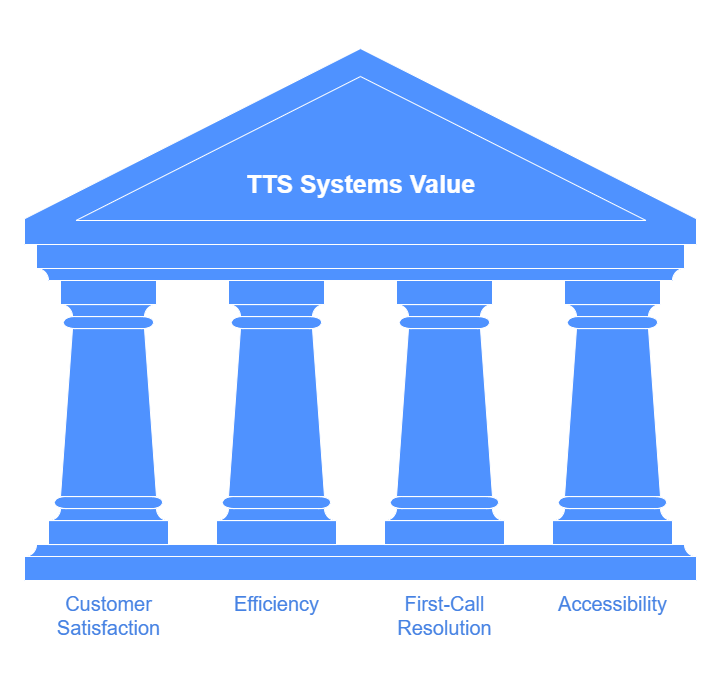
Future Trends in Business TTS Applications
Businesses are getting more into voice user interfaces, ai text to speech, and conversational ai. The future of text-to-speech (TTS) technology in business is looking bright. AI and machine learning will make voices sound more natural and responses more aware of context.
This change will change how companies talk to their workers and customers. It’s a big deal for communication.
There’s a new trend in TTS: making voices for many languages and adding emotions. This will help companies talk to people all over the world better. They can share content that feels right for each culture.
By combining TTS with tech like augmented reality and the Internet of Things, we’ll see new uses in many fields. This will change how businesses talk and work.
Reports say the Text-to-Speech market will grow a lot. It’s expected to hit $9.3 billion by 2030, growing 13.4% each year. The U.S. and China will lead this growth.
As more businesses see the value of these technologies, TTS’s future in business looks good. It can make customers happier, help everyone access information, and make talking inside companies easier. TTS is becoming key for businesses today.
“The integration of TTS with other emerging technologies like augmented reality and the Internet of Things is likely to create new applications in various industries, further transforming business communication and operations.”
Conclusion about TTS in Business Communication
Text-to-speech (TTS) technology has changed how businesses talk to customers and handle things inside. It makes things easier for people with vision problems or who speak different languages. TTS also helps make content and customer service better.
TTS is getting better thanks to AI and machine learning. Soon, it will do even more cool things. Companies can use natural-sounding voices in many languages to make audio content that’s fun and personal. This makes customers happier and helps businesses work better.
Using TTS in business has many good points. It helps with automated customer service, gets past language issues, and makes things more accessible. This all leads to happier customers and better teamwork at work.
If you’re interested in how TTS can transform business communication, we recommend checking out these articles:
- TTS for E-Learning: How TTS enhances the online learning experience.
- TTS vs Human Voices: Compare human voices with AI solutions in business communication.
- How to Create Audiobooks with AI Voice Generation: Turn your texts into audiobooks with TTS technology.
These articles will provide you with additional insights and inspiration for integrating TTS into various fields.
FAQ’s about TTS in Business Communication Systems
What is TTS in Business Communication Systems?
TTS in Business Communication Systems turns written text into spoken language. It makes things more accessible and efficient. It also helps in engaging customers across different business areas.
What are the core components of TTS in business communication systems?
TTS in business systems has three main parts: text analysis, linguistic processing, and voice synthesis. The system’s architecture is about linking TTS with current business systems. It uses APIs for voice calls and AI for voice understanding.
What are the benefits of implementing TTS in business operations?
Using TTS in business operations brings many benefits. It makes things more accessible and efficient. It also lets businesses customize voices, languages, and accents.
It improves customer experience with virtual assistants and voice-guided services. It makes business processes smoother and customer interactions more personal and engaging.
How can TTS be used in customer service applications?
TTS is used in customer service in many ways. It includes advanced IVR systems and automated customer communications. TTS-powered IVR systems can handle complex questions without needing a human.
Automated customer communications make delivering updates and personalized messages more efficient.
How can TTS enhance accessibility and user experience in business communications?
TTS technology makes business communications more accessible and user-friendly. It provides audio content for visually impaired users or those who prefer listening. It helps students with reading challenges and language learners.
It also improves customer service by delivering messages clearly and consistently.
What are the key considerations for implementing TTS in business systems?
To implement TTS in business systems, careful planning is needed. You must assess technical needs and test thoroughly before starting. Planning involves identifying business needs and use cases.
Technical aspects include choosing the right TTS provider and ensuring it works with current systems. You also need to address security concerns.
How can the performance of TTS systems be measured?
To measure TTS system performance, look at customer satisfaction, call handling times, and first-call resolution rates. Also, consider operational efficiency gains. Key indicators include accessibility compliance, training cost reductions, and higher customer engagement.
What are the future trends in business TTS applications?
Future TTS systems will be more advanced and integrated. AI and machine learning will make voices sound more natural and responses more aware of context. There will be more multilingual and emotion-aware TTS systems.
This will improve global communication. TTS will also be integrated with emerging technologies like augmented reality and the Internet of Things. This will lead to new applications in various industries.
Source Links
- https://medium.com/neuralspace/text-to-speech-101-the-ultimate-guide-9a4b10e20fef
- https://voiso.com/articles/text-to-speech-what-it-is-and-how-it-can-transform-your-cx/
- https://www.readspeaker.com/blog/text-to-speech-meaning/
- https://techpilot.ai/understanding-text-to-speech-technology/
- https://ignitetech.ai/about/blogs/text-speech-evolution-synthetic-voices
- https://startup-house.com/blog/react-native-tts-business-communication
- https://botpenguin.com/glossary/speech-synthesis


